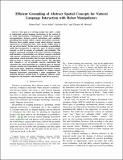Efficient Grounding of Abstract Spatial Concepts for Natural Language Interaction with Robot Manipulators
Author(s)
Paul, Rohan; Arkin, Jacob; Roy, Nicholas; M. Howard, Thomas
Downloadp37.pdf (23.87Mb)
OPEN_ACCESS_POLICY
Open Access Policy
Creative Commons Attribution-Noncommercial-Share Alike
Terms of use
Metadata
Show full item recordAbstract
Our goal is to develop models that allow a robot to understand natural language instructions in the context of its world representation. Contemporary models learn possible correspondences between parsed instructions and candidate groundings that include objects, regions and motion constraints. However, these models cannot reason about abstract concepts expressed in an instruction like, “pick up the middle block in the row of five blocks”. In this work, we introduce a probabilistic model that incorporates an expressive space of abstract spatial concepts as well as notions of cardinality and ordinality. The graph is structured according to the parse structure of language
and introduces a factorisation over abstract concepts correlated with concrete constituents. Inference in the model is posed as an approximate search procedure that leverages partitioning of the joint in terms of concrete and abstract factors. The algorithm
first estimates a set of probable concrete constituents that constrains the search procedure to a reduced space of abstract concepts, pruning away improbable portions of the exponentiallylarge search space. Empirical evaluation demonstrates accurate grounding of abstract concepts embedded in complex natural language instructions commanding a robot manipulator. The proposed inference method leads to significant efficiency gains compared to the baseline, with minimal trade-off in accuracy.
Date issued
2016Department
Massachusetts Institute of Technology. Computer Science and Artificial Intelligence Laboratory; Massachusetts Institute of Technology. Department of Aeronautics and AstronauticsJournal
Robotics: Science and Systems XII
Publisher
Robotics: Science and Systems Foundation
Citation
Paul, Rohan, Jacob Arkin, Nicholas Roy, and Thomas M. Howard. “Efficient Grounding of Abstract Spatial Concepts for Natural Language Interaction with Robot Manipulators.” Robotics: Science and Systems XII (n.d.), Ann Arbor, Michigan, Robotics: Science and Systems Foundation, 2016.
Version: Author's final manuscript
ISBN
9780992374723